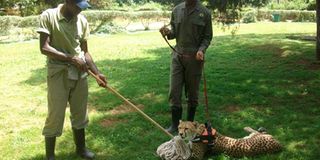Racing with cheetahs

Tour guides train one of the cheetahs how to sense the mop.
What you need to know:
- With final works on the cheetah exhibit finalised in December, preparation is being done on the necessary stretch which will give visitors a safe setting to run with the cheetahs.
- Only a handful of parks have this adventure. At the San Diego Zoo Safari Park located in San Diego’s north county, in the US, the Cheetah run gives park guests the opportunity to witness the world’s fastest land mammal do what it does best – run!
Have you ever dreamt about racing with the fastest animal on earth?
Well, before you know it, you will be able to race with cheetahs. The Uganda Wildlife Education Centre commonly known as Entebbe zoo will help you realise this dream with the launch of the Cheetah Run.
This will be the first of its kind in Uganda with the centre having two cheetahs Pian and Upe which were rescued from the Pian Upe Wildlife Reserve in Karamoja.
According to the centre’s executive director, James Musinguzi, this is aimed at creating an unforgettable experience for tourists.
“Tourism is about experiences, therefore, we want people to experience a run with the fastest animal in the world as a special and unique experience in Uganda which will create repeat visits but also showcase Uganda’s unique tourism attractions and products,” Musinguzi says.
The cheetah will be within the exhibit and the person will be outside the exhibit in the race way.
Preparing the animals
When I visited the centre, I met the cheetah keeper and trainers Joseph Ogwang and Robert Olupot taking out the cheetahs for some exercises. This is done at a square close to the animal hospital at UWEC.
“What we are about to do here is the cheetah sprint. Along this stretch, we use a mop to try and represent prey, so these guys (Cheetahs) chase it as they would for any prey they are going after. They have been trained to be lured by this mop,” Ogwang explains.
One of the trainers stands at the end of the trail with the mop and a whistle, and when the whistle is blown, the cheetahs are released to run after the mop that is at that moment being swung in all directions.
And when the cheetahs get close to the trainer, he runs forward with the mop, forcing the cheetahs to run after him in an attempt to pounce on their “prey”.
Ogwang says this is a very interesting experience which is done a couple of times and encourages members of the public to come and enjoy this experience, however, he cautions them not to bring along their children for this particular activity.
“We do it for adults and not for children because cheetahs have been known to strike them,” Ogwang says.
He says because cheetahs are known to tire out very fast, about two or three runs are done and they are left to rest a bit and given a treat.
With final works on the cheetah exhibit finalised in December, preparation is being done on the necessary stretch which will give visitors a safe setting to run with the cheetahs.
Ogwang reveals that when all is set, they will no longer use the mop system to have the cheetahs run, but rather put up a more modern pulley system. He elaborates: “We are looking at having a more modern system which will use a dummy that looks like a rodent which runs on a pulley system and it is very fast. These cheetahs will be trained to chase that.”
Musinguzi says this exercise is not only aimed at offering fun for the visitors but also ensuring the welfare and health of the animals.
“These cheetahs are supposed to be running up and down in the wild. We are trying to recreate their life in the wild, therefore, we want them to live a naturalistic life by exercising and running around in a process we call enrichment, which ensures adequate welfare for the animals in our care,” he says.
Not a common venture
Only a handful of parks have this adventure. At the San Diego Zoo Safari Park located in San Diego’s north county, in the US, the Cheetah run gives park guests the opportunity to witness the world’s fastest land mammal do what it does best – run! The cheetah runs off-leash, chasing a mechanical lure down a 330-foot track, showcasing its ability to go from 0 to 70 mph in just 4 seconds.




